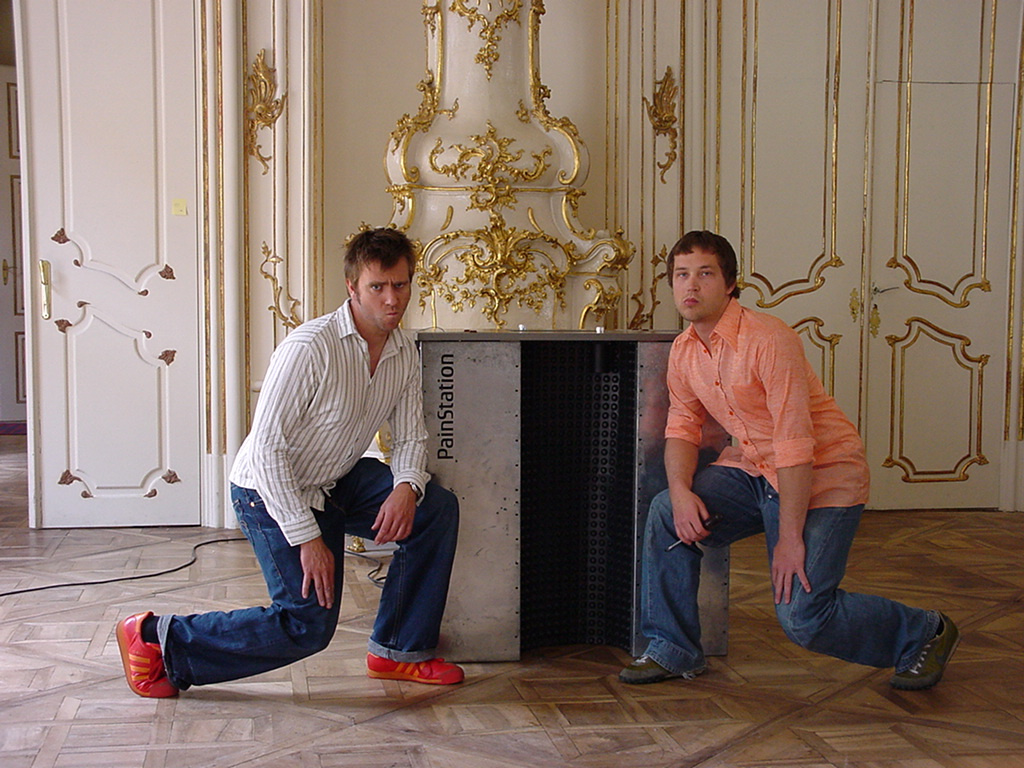FUR – Biography
Volker Morawe (born 1970) and Tilman Reif (born 1971) are the artists behind //////////fur//// art entertainment interfaces. The artist duo counteracts our relationship to the increasing digitalization of everyday life, above all, with regard to the games culture, by way of amusing and rebellious digital devices.
The two artists, who have been working together since their studies at the Academy of Media Arts Cologne, made a name for themselves with the project »Pain Station«, ongoing project since 2001. This is a pain-inducing critical encounter with the classic game »Pong«. Instead of simply experiencing the annoyance caused by a lost game, the losing party is punished in the form of little electric shocks or lash of the whip. Morawe and Reif transfer ironic games concepts and communications theories to the sphere of objects. Their devices run counter to user expectations. This results in different kinds of experiences by way of an entirely different emphasis on the playful. //////////fur//// investigate the concept of interaction in the form of designed experience spaces. Thus, their creations are also works of classic sculpture reflecting contemporary critical attitudes to a world shot through with Smartphone, games consul and computer screens. Furthermore, their parodies reveal the anemia and the phantasm of an apparently ideal man-machine interaction, as propagated by big IT corporations.
//////////fur//// have exhibited their works at the MOCA, Shanghai, or the MoMA, New York, and have received several awards, such as the Japan Media Arts Award. Among other things, they have received the Honorary Mention of Ars Electronica and the ZKM International Media Art Award.
The Technical Structure of the AOYS-Projekts *OIS*
The basis of the One-way Interaction Sculpture *OIS* is the mini-computer Raspberry Pi (RPi) model B, which is connected to the Internet by Ethernet. The control of the lamp is operated by means of a General Input Output Port (GPIO) of the RPi, which also serves as a means to follow the respective status of the lamp (on/off). A Polulu-Maestro-Board is an additional hardware module that controls the servo and which, in turn, mechanically operates both switch and locking device. A server, developed in JavaScript (on the basis of Node.js) using the following library, is installed in the RPi: Express (HTTP-server), Jade (Template Engine), Socket.io (Realtime-Connection with Frontend), OnOff (GPIO Access), pololu-maestro (Library for Pololu-Maestro Board), using HTML-Frontend, Angular.js (Web-Application Framework), socket.io (Realtime-Connection with Backend).
Node.js plays a special role in configuration. It is a resource-saving, event-based platform optimized, above all, for processing a large number of simultaneous connections. This is its distinguishing feature, setting it apart from other web servers that answer requests synchronously. In the case of asynchronous, event-based processing the thread does not have to wait: It »parks« the current request while processing other events works, until the relevant event (e. g. »required file loaded«) leads it once again to the parked request.
Bibliography
- Martin Dunkelmann, »fur: Sie geben der Kunst den Humor zurück«, in: arte Creative magazin, 19.08.2013, www.creative.arte.tv/de/magazin/fur-sie-geben-der-kunst-den-humor-zurueck, 09.04.2014
- Tilman Baumgärtel, Hartware MedienKunstverein (ed.): Games. Computerspiele von KünstlerInnen. Frankfurt/Main (Revolver) 2003, p. 76-77 Andreas Lange, Pong.Mythos. Ein Ball und zwei Schläger. Ein Spiel und seine Folgen. Berlin, 2006, p. 29
- FUR. Spiel und Schmerz. Ein Gespräch von Mathias Fuchs, in: Kunstforum International Vol. 178 »Kunst und Spiel«. Ruppichteroth, 2005, p. 140-145
Author: Matthias Kampmann
